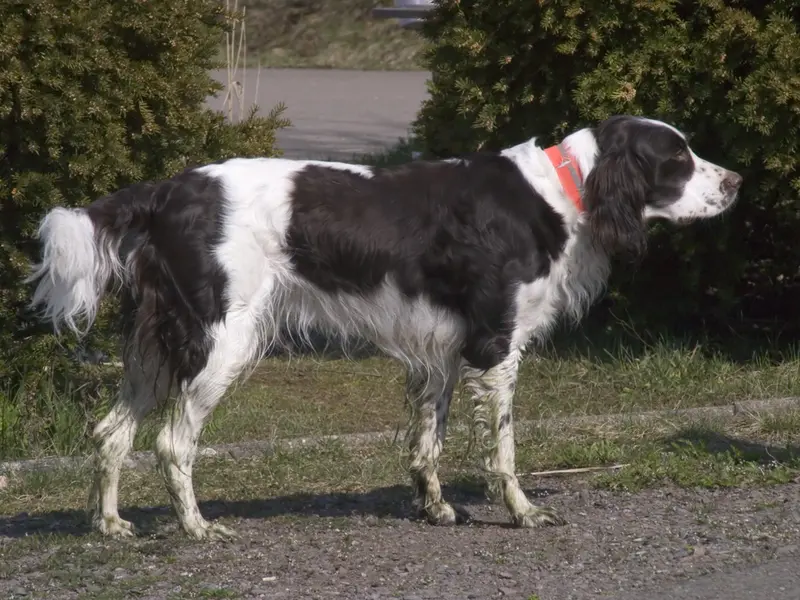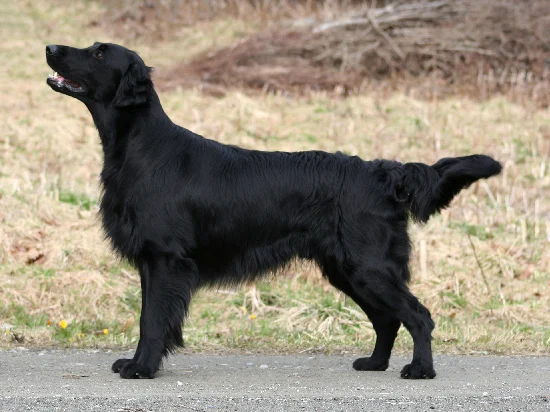Field Spaniel
The Field Spaniel is a medium-sized, cheerful, and affectionate breed known for its hunting abilities and loving nature. With a rich history and a playful temperament, they make excellent family companions.
Overview
🐕Breed Overview
✨Key Traits
💡What Makes Field Spaniel Special
Field Spaniels are characterized by their strong work ethic and versatility. They excel in hunting and retrieving, making them excellent companions for active owners.
Their affectionate nature and desire for human interaction make them ideal family pets. They are also known for their intelligence and trainability, often excelling in obedience and agility training.
Their docile temperament allows them to adapt well to various living situations, provided their exercise needs are met. Field Spaniels are not just hunting dogs; they are loving companions that thrive on being included in family life.
The Field Spaniel is a medium-sized breed that embodies a perfect blend of beauty and utility. Originating in England in the mid-1800s, this breed was initially developed for hunting and retrieving game birds. With a history intertwined with the Cocker Spaniel, the Field Spaniel was recognized as a separate breed in 1892.
Despite facing near extinction due to misdirected breeding practices, dedicated breeders revived the breed in the mid-20th century, honing its appearance and hunting abilities. Today, the Field Spaniel is celebrated for its cheerful, affectionate, and fun-loving temperament, making it an excellent family companion. Field Spaniels are known for their striking appearance, with a silky coat that comes in various colors, including black, liver, and golden liver.
Their long, low-slung bodies are built for endurance, allowing them to navigate dense cover and water with ease. With a height of 17 to 18 inches and a weight ranging from 35 to 50 pounds, they are well-proportioned and sturdy. These dogs are happiest when they have a job to do, whether it's hunting, participating in agility trials, or simply being included in family activities.
They thrive on human companionship and require daily exercise to keep them physically and mentally stimulated. Regular grooming is necessary to maintain their coat and minimize shedding. Field Spaniels are known for their intelligence and trainability, making them suitable for various roles, including therapy work and detection tasks.
Their affectionate nature and playful demeanor make them great companions for families, while their independent streak means they can also enjoy time alone. Overall, the Field Spaniel is a rare breed that combines beauty, versatility, and a loving disposition, making them a cherished addition to any home.
🎉Fun Facts
Field Spaniels excel in various dog sports, including agility and obedience trials.
Field Spaniels were nearly extinct in the 20th century but were revived by dedicated breeders.
They are known for their gentle temperament and are great with children.
Breed Characteristics
Family & Friends
Good Behavior
Get Up & Go
Household Harmony
Temperament & Personality
✨Key Traits
🐕Core Temperament
The Field Spaniel is known for its gentle and docile temperament. They are affectionate and loyal to their families, often forming strong bonds with their owners.
While they can be independent, they thrive on companionship and enjoy being included in family activities. Their playful nature makes them great with children, and they are generally good with other pets.
With proper socialization, they can be reserved around strangers but are not typically aggressive. Their temperament is characterized by a balance of independence and a strong desire to please.
💫Personality Profile
Field Spaniels are known for their cheerful and affectionate nature. They thrive on human companionship and enjoy being part of family activities.
While they can be independent, they are eager to please and respond well to training. Their playful demeanor makes them great companions for children, and they are generally good with other pets.
However, they may be reserved around strangers, requiring proper socialization from a young age. With regular exercise and mental stimulation, they are well-behaved and content family members.
🔊Vocal Tendencies
Field Spaniels have a moderate barking tendency. They may bark to alert their owners of strangers or unusual sounds but are not known to be excessive barkers.
Their vocalizations can vary based on their mood and environment. While they may bark during play or when excited, they are generally not overly noisy dogs.
Proper training and socialization can help manage any excessive barking tendencies.
Affection & Social Traits
Energy & Activity
Communication Style
Care Requirements
🏃♂️Exercise Requirements
Daily Exercise
Field Spaniels are active dogs that require a significant amount of exercise to maintain their physical and mental well-being. Ideally, they need at least 60 to 90 minutes of vigorous exercise each day.
This can include activities such as long walks, runs, swimming, or engaging in dog sports like agility and obedience training. Puppies may require shorter, more frequent play sessions to avoid overexertion, while senior dogs may benefit from gentler activities such as leisurely walks or swimming to protect their joints.
Regular exercise not only helps manage their weight but also reduces the risk of behavioral issues stemming from boredom or pent-up energy. Insufficient exercise can lead to destructive behaviors, anxiety, and obesity, making it crucial for owners to provide ample opportunities for physical activity.
Preferred Activities
🏠Living & Adaptability
Space Requirements
Field Spaniels thrive in homes with ample outdoor space where they can run and explore. A fenced yard is ideal to allow them to roam freely while ensuring their safety.
They can adapt to apartment living if their exercise needs are met through regular outdoor activities. However, they are not suited for city living due to their need for space and the opportunity to engage in natural behaviors.
Owners in smaller living spaces should ensure they provide daily outings to parks or open areas to fulfill their exercise and socialization needs.
Climate Preference
🍲Feeding Guide
Schedule
Food Types
Portion Size
Special Nutritional Needs
Field Spaniels may benefit from a diet rich in protein to support their active lifestyle. It's important to choose high-quality dog food that meets their nutritional needs.
Some dogs may have sensitivities to certain ingredients, so monitoring their reactions to food is essential. Regular veterinary check-ups can help identify any specific dietary requirements.
✨Grooming Requirements
Grooming Overview
Field Spaniels have a moderately long, silky coat that requires regular grooming to prevent matting and maintain its appearance. Owners should brush their dog's coat at least once a week, using a slicker brush to remove loose hair and debris.
The hair inside the ears and between the foot pads should be clipped regularly to prevent irritation. Additionally, trimming around the feet, throat, and upper ears may be necessary for show dogs.
Bathing should be done as needed, typically every few months, to keep the coat clean and healthy. Regular ear cleaning is also important to prevent infections, as their floppy ears can trap moisture.
Care Schedule
Brush weekly, bathe as needed (every few months), trim nails every two weeks, and check ears regularly.
Health Profile
⚕️Health Care
Regular veterinary care is essential for maintaining the health and lifespan of Field Spaniels. Routine check-ups, vaccinations, and preventive treatments can help detect and address health issues early.
Owners should also be proactive in monitoring their dog's weight, dental health, and overall well-being. Providing a balanced diet, regular exercise, and mental stimulation are key factors in promoting a long and healthy life for this breed.
Health Issues Overview
⏳Average Lifespan
Genetic Factors
Genetics play a crucial role in the lifespan of Field Spaniels. Responsible breeding practices that prioritize health and genetic diversity can help reduce the risk of hereditary health issues.
Potential owners should seek reputable breeders who conduct health screenings for common conditions affecting the breed, such as hip dysplasia and eye disorders. Understanding the genetic background of a dog can provide insights into its potential health risks and longevity.
Living Conditions
Field Spaniels thrive in environments that allow for regular physical activity and mental stimulation. Access to outdoor spaces for exercise, such as parks or fields, can significantly enhance their quality of life and longevity.
Social interactions with humans and other pets also contribute to their emotional well-being. A stable and loving home environment, along with routine veterinary care, can help ensure a longer lifespan for these dogs.
🏥Common Health Issues
Hip Dysplasia
Warning Signs
🔬Diagnosis
X-rays and physical examination by a veterinarian.
💊Treatment
Weight management, pain relief medications, and in severe cases, surgery.
📝Management Tips
Maintain a healthy weight, provide joint supplements, and engage in low-impact exercise.
Otitis Externa
Warning Signs
🔬Diagnosis
Ear examination by a veterinarian.
💊Treatment
Ear cleaning solutions and medications as prescribed by a veterinarian.
📝Management Tips
Regular ear cleaning and monitoring for signs of infection.
Hypothyroidism
Warning Signs
🔬Diagnosis
Blood tests to measure thyroid hormone levels.
💊Treatment
Thyroid hormone replacement therapy.
📝Management Tips
Daily medication and regular veterinary check-ups.
🛡️Preventive Care
🔬Hip Evaluation
Hip Evaluation: Assesses the hip joints for dysplasia and other abnormalities.
📅 Recommended at 12 months and every few years thereafter.
🔬Eye Examination
Eye Examination: Screens for hereditary eye conditions such as cataracts and retinal issues.
📅 Annually, especially for breeding dogs.
🔬Thyroid Function Test
Thyroid Function Test: Evaluates thyroid hormone levels to detect hypothyroidism.
📅 Every 1-2 years, or if symptoms arise.
Training
🧠Intelligence & Trainability
💪Work Drive
Field Spaniels possess a strong work drive and thrive when given tasks to complete. Their history as hunting dogs means they enjoy activities that challenge their physical and mental abilities.
Engaging them in hunting exercises, agility training, or scent work can provide the stimulation they need to stay happy and fulfilled. Without a job or purpose, they may become bored and exhibit destructive behaviors.
Providing regular opportunities for mental and physical engagement is crucial for their overall well-being.
⚠️Training Considerations
Field Spaniels can exhibit independent behavior, which may pose challenges during training. They may become easily distracted or stubborn if not properly motivated.
To overcome these challenges, it is essential to use positive reinforcement techniques, such as treats and praise, to encourage desired behaviors. Consistent training sessions that incorporate fun activities can help maintain their interest and focus.
Socialization from a young age is crucial to prevent shyness or reserved behavior around strangers and other dogs. Engaging them in various environments and exposing them to different people and animals can help them develop confidence and adaptability.
📝Training Tips
Training a Field Spaniel requires patience and consistency. Start with basic obedience commands and gradually introduce more complex tasks.
Use positive reinforcement methods to reward good behavior, and keep training sessions short and engaging to maintain their attention. Incorporating play into training can help reinforce commands while making it enjoyable for the dog.
Regular socialization with other dogs and people is essential to develop their confidence and reduce any reserved tendencies. Consider enrolling in obedience classes or working with a professional trainer to enhance their training experience.
History & Heritage
📜Origin Story
The Field Spaniel's story begins in the lush landscapes of England, where it was developed as a versatile hunting companion. Initially bred from larger land spaniels, including the Cocker Spaniel and Sussex Spaniel, the Field Spaniel was recognized for its ability to flush and retrieve game.
Despite its promising start, the breed faced challenges due to breeding for exaggerated traits, leading to a decline in its working abilities and popularity. The mid-20th century saw a concerted effort by breeders to restore the Field Spaniel to its former glory, resulting in a resurgence of interest and appreciation for this unique breed.
Today, the Field Spaniel is a testament to the dedication of those who sought to preserve its legacy.
⏳Development History
The Field Spaniel originated in England in the mid-1800s, sharing its early lineage with the Cocker Spaniel. Initially, the breed was recognized for its larger size and hunting capabilities.
In 1892, it was officially deemed a separate breed. However, due to misdirected breeding practices, the Field Spaniel faced a decline in popularity and nearly became extinct.
In the 1950s, dedicated breeders worked to revive the breed, focusing on restoring its original appearance and hunting prowess. Today, the Field Spaniel is celebrated for its balanced temperament and versatility in various roles, including hunting and companionship.
🛡️Purpose & Historical Role
Historically, the Field Spaniel was bred for flushing and retrieving game birds, making it an essential companion for hunters. Its ability to work in dense cover and water made it a valuable asset in the field.
Over time, the breed's role has evolved, and while it remains a capable hunting dog, it is also cherished as a family pet and companion. The Field Spaniel's gentle nature and willingness to please have made it a popular choice for families seeking an affectionate and loyal dog.
🏺Cultural Significance
The Field Spaniel has a rich history tied to the development of spaniel breeds in England. Originally bred for hunting and retrieving game, they were admired for their versatility and gentle temperament.
Their near extinction in the mid-20th century highlighted the importance of dedicated breeding programs aimed at preserving their unique qualities. Today, they are recognized not only for their hunting abilities but also as affectionate family companions, making them a rare yet cherished breed among dog enthusiasts.
Conservation Status
This breed is rare and not commonly found outside its region of origin.









